Do you confuse Delta Hotels by Marriott with Delta Air Lines? Members of the team at the airline claim that Marriott International, Incorporated has been purposely attempting to pass off its Delta Hotels branded hotel properties as being associated with the airline…
Do You Confuse Delta Hotels by Marriott With Delta Air Lines?
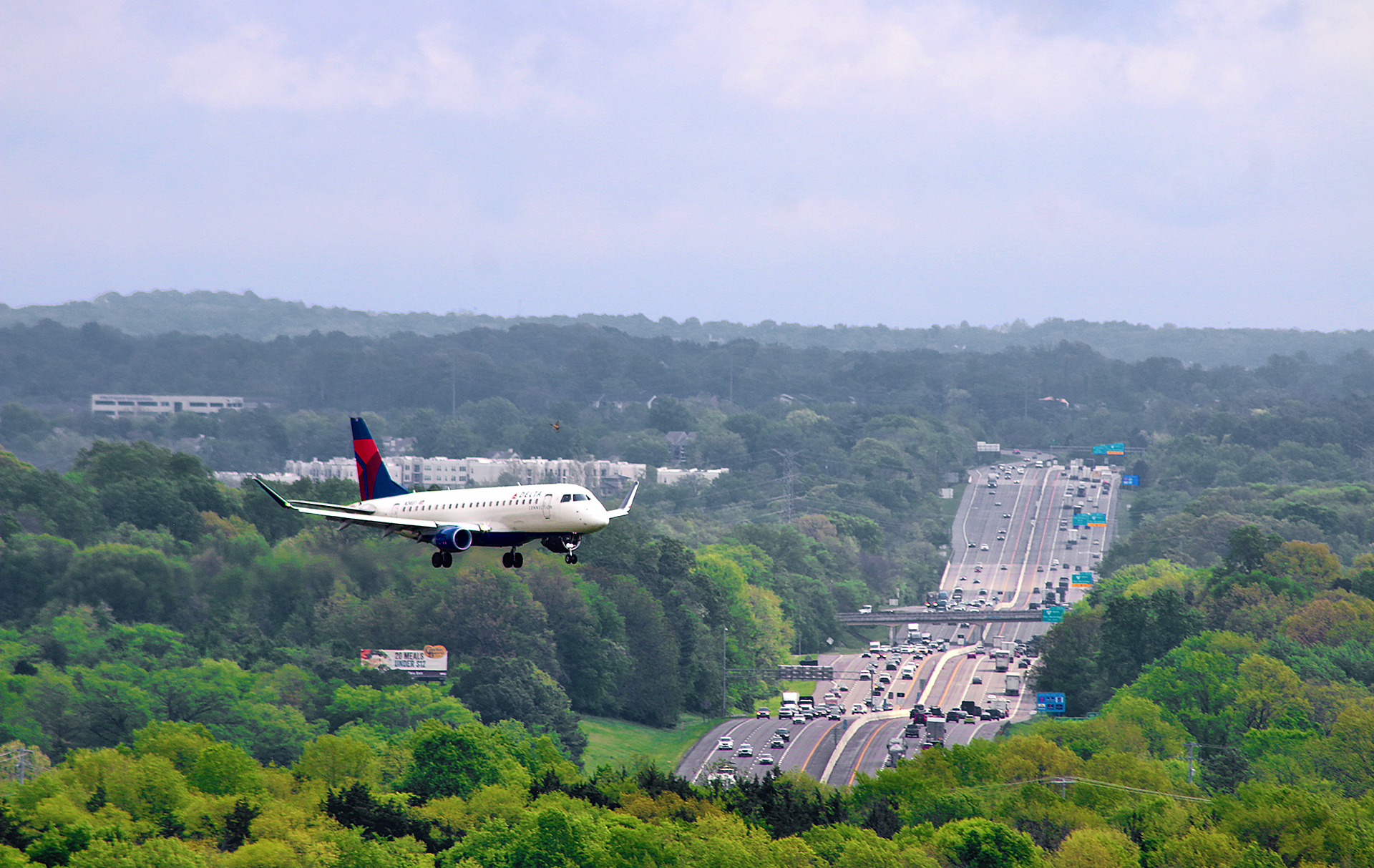
…so much so that one lawsuit was filed in the District Court for the Northern District of Georgia of the United States back in 2020 and is now underway in Atlanta; while another lawsuit was formally filed in the High Court of Justice of England and Wales back in 2024 over the dispute — despite an agreement between the two companies in 2015 which allowed for the brands to coexist in specific international markets.
The contention is that Marriott International, Incorporated changed the branding of Delta Hotels — including but not limited to changing the color scheme of the logotype to a darker blue while adopting a sans serif font — so it would be closer to that of the airline in order to allegedly:
- Purposely confuse consumers
- Ease the expansion of Delta Hotels outside of Canada, where the brand was founded greater than 63 years ago
- Undermine the brand of the airline, which many people perceive as synonymous with premium service
- Dilute the distinctiveness of its trademarks
- Create unnecessary overlap in the greater travel marketplace, as both companies operate their businesses within the travel and hospitality industry and share overlapping customer bases, marketing channels, and loyalty initiatives
Delta Air Lines may be indirectly attempting to protect its Delta Stays platform for booking hotel and resort properties, as that is the current foray of the airline into the global lodging industry. Increasing numbers of partnerships between airlines and lodging companies can also blur boundaries and lead to confusion among customers; so clear brand differentiation is arguably more important than ever.
Marriott International, Incorporated reportedly attempted to secure a trademark protection for the word Delta in 2020, which was met with opposition from Delta Air Lines. Both the Intellectual Property Office of the United Kingdom and the High Court of Justice of England and Wales sided with Delta Air Lines in part by excluding protections for the terms retail stores and hotel services, which reduced some of the trademark protections of Marriott International, Incorporated.
Multiple companies have the word delta included in their names — including Delta Dental Plans Association, Delta Clothing, Delta Welding & Fabrication, and Delta Faucet Company, with many of them using a triangle as part of their logos which is supposed to emulate the Greek letter Delta or Δ — but none of them directly conduct business in the broader global travel industry.
Also, companies with the same name in different sectors of the global travel industry is not unprecedented — such as National Airlines and National Car Rental as one example. National Airlines ceased operations in 1980 when it merged with Pan American Airways; and a different entity called National Airlines had since been founded and ceased operations as well; so the name National is currently not an issue.
History of Delta Hotels and Resorts
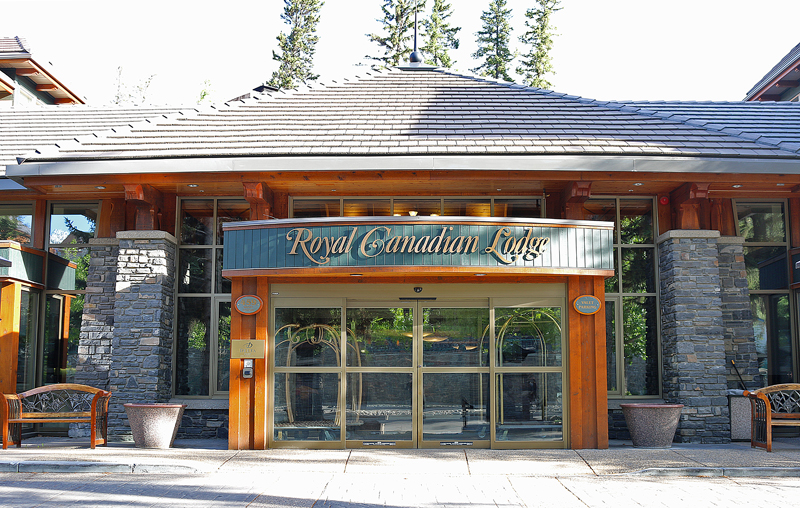
The Delport Inn was opened with 68 rooms in Richmond in British Columbia by William Pattison and his business partners in June of 1962. In September of the same year, Western Hotels — which eventually became Western International Hotels in January of 1963 to reflect its growth into Canada outside of the United States — changed the name of the property to the Vancouver Airport Inn and assumed the management until January of 1964.
Four motel properties were constructed on Vancouver Island by what became known as Delta Developments between 1965 and 1967 with the lease or purchase of two additional motel properties in British Columbia. Because Driver Developments — which purchased Delta Developments in 1969 — experienced serious financial difficulties from its diverse investment portfolio within months, Delta Hotels Limited assumed the ownership and operation of the properties in 1970. The portfolio was reduced to four properties by the middle of 1974…
…but despite being sold at least twice, the chain of hotel properties eventually grew to 24 in several provinces in Canada by 1999, with only one lone property located within the United States.
After another acquisition in 1999, Delta Hotels Limited became a wholly owned subsidiary of Fairmont Hotels and Resorts. The brand was yet again acquired in 2007 — this time by British Columbia Investment Management Corporation — and the portfolio comprised of 40 hotel properties by 2013.
On Monday, January 5, 1981, the name Western International Hotels became Westin Hotels, with Westin being a combination of the words western and international. Westin Hotels was then sold in 1994 to Starwood Capital Group, which achieved full ownership of the brand in 1998 before Marriott International, Incorporated announced its acquisition of Starwood Hotels and Resorts Worldwide, Incorporated in November of 2015 for $12.2 billion to become the largest lodging company in the world at that time; and also prior to Delta Hotels and Resorts being acquired by Marriott International, Incorporated in 2015 for approximately $135 million. At the completion of the acquisition, Marriott International, Incorporated became the largest full service hotel company in Canada with greater than 120 hotel properties and 27,000 rooms — and as a result, both Westin Hotels and Delta Hotels were reunited under the same ownership once again.
Ironically, hotel properties of Delta Hotels in the United States currently outnumber those in Canada.
I wrote about my underwhelming experience at a hotel property that was then called Delta Hotels Banff Royal Canadian Lodge — even thought the Delta Hotels brand was more upscale then than it is today.
Logo and Design Issues

When what was called the “onward and upward” brand identity was introduced for Delta Air Lines as the airline emerged from bankruptcy back in 2007, I pointed out at least a couple of issues in this article back on Sunday, May 8, 2016.
First, the trend was to use sans serif typefaces — whether or not they were customized — for the logotypes of airlines, as shown in Figure 1 on the left. In the case of both United Air Lines and Delta Air Lines, both logotypes were colored in blue. When seen together, the blues are of different shades — but when looking at the liveries of airplanes at an airport, one may not immediately notice the difference in the blue colors of each logotype. Each logotype looks “clean” and “modern” — but they could be considered inherently bland to evoke an airline and the movement of an airplane.

The second issue is that the “widget” of Delta Air Lines was quite unique when its colors were solid blue on top and solid red on the bottom; and separated by an angled white space. When the colors of the “widget” became two shades of red — apparently, to evoke dimension, among other aspects — the logo of Citgo immediately came to mind, as shown in Figure 2 on the left.
Although both the logotype and the “widget” combined to form an identity for Delta Air Lines which is now immediately recognized as part of the brand, the individual components are hardly original in their present forms…
…so if a company decides to incorporate a red triangle of some form with a blue logotype that is comprised of sans serif letters that are at least one shade of blue, does that infringe on the brand of Delta Air Lines?
The obvious answer depends on the overall integrated design itself — which leads us to the current logo of Delta Hotels.
Although both the logotype and the stylized D logo of Delta Hotels have changed since the lodging company was acquired by Marriott International, Incorporated in 2016…
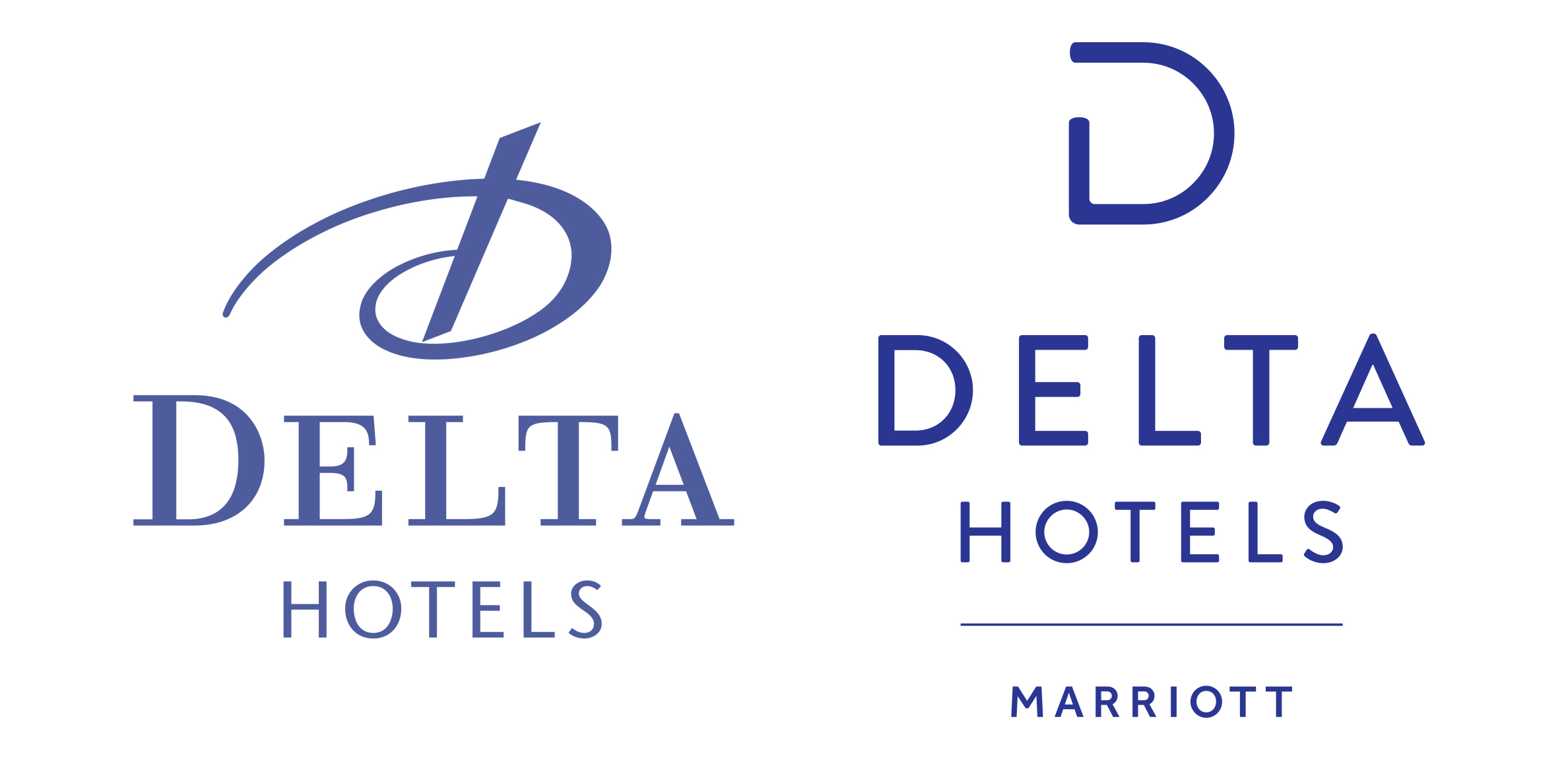
…one could argue that the current logotype of Delta Hotels is closer in appearance to that of Delta Air Lines than the former logotype, which used a serif typeface. The stylized D looks nothing like the “widget” of Delta Air Lines.
Where Delta Air Lines might have a case is that the logotype in the current logo of Delta Hotels does initially look similar to that of the airline simply because the style of the letters seem to be similar…
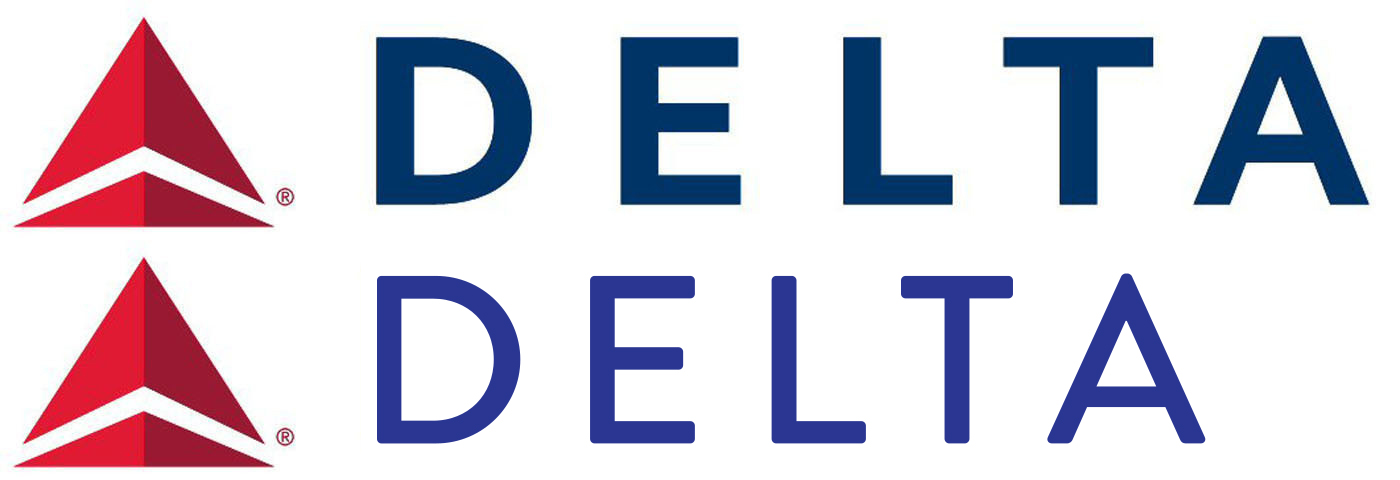
…but they are indeed different when immediately compared to each other. The Delta Hotels logotype is:
- A different shade of blue
- A lighter weight of typeface
- Comprised of letters that are spaced closer together
- Comprised of letters with slightly rounded corners rather than hard defined corners

I would argue that the currently logotype — and not necessarily the logo itself, which is comprised of three water droplets in the shape of a triangle within a circle — for Delta Faucet Company more closely resembles that of Delta Air Lines than Delta Hotels. Delta Faucet Company was founded in 1954 and is unrelated to travel — unlike Delta Hotels.
Final Boarding Call
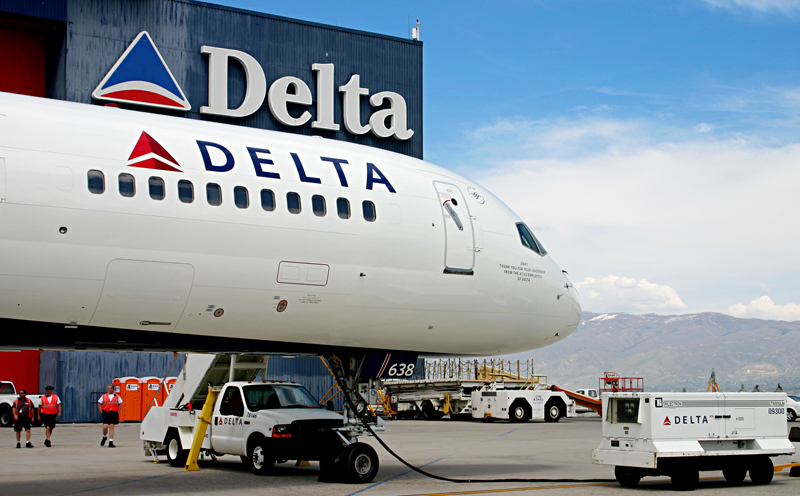
A company named Delta Apparel — with brands such as Salt Life — ceased operations earlier this year. Should this company have sued Delta Air Lines for being in the apparel business?
I have been involved in graphic design and branding for much of my life, with a Bachelor of Fine Arts degree I earned from Parsons School of Design in New York and at least one business that I launched with which I have served clients for years. I have designed logos for companies myself. In my opinion, Delta Air Lines ultimately does not have a case, as the burden is on the airline to prove that Marriott International, Incorporated is indeed “hijacking” — pun intended — the branding and goodwill of the airline; that a significant number of customers have mistakenly reached out to the wrong company with complaints and inquiries; and that the airline clearly suffered damages to its business as a result. The fact that Delta Hotels has been in the lodging business for greater than 63 years and that the airline and the multinational lodging company are technically in different industries even though they both conduct business within the greater travel industry in general does not help Delta Air Lines with its case — nor does the fact that the logotypes are indeed different as proven in this article; and that Marriott clearly has its name prominently featured in the current Delta Hotels logo.
The only time I experience any sort of inconvenience between Delta Hotels by Marriott and Delta Air Lines is either when I search for photographs for an article or apply a “tag” using the term Delta, as I did with this article. Otherwise, I have never confused the airline with the lodging brand — and I do not know anyone else that has suffered from such confusion.
If I were the chief executive officer of Marriott International, Incorporated, I would have considered changing the name Delta Hotels to another name to have avoided this controversy in the first place, as it was well known only in Canada prior to the acquisition by Marriott…
…and with at least 35 brands in its portfolio, what in the world is so distinctive about Delta Hotels, anyway? If the brand cannot be renamed, why not simply roll it into another existing brand that is in the mid-scale tier, of which Marriott has plenty? Why would a multinational lodging company that is successful in its own right purposely attempt to mislead guests with the name and logo of an airline that has been in business for greater than 100 years and whose name is originally derived from the Mississippi Delta region of the United States?
I find this entire issue substantially illogical at best; but I believe that both Delta Air Lines should drop the lawsuit and Marriott International, Incorporated should change the unappealingly bland logo of Delta Hotels — and perhaps change the name to something that better describes the brand and what guests can expect to experience during their stays…
All photographs ©2007, ©2017, and ©2024 by Brian Cohen.

